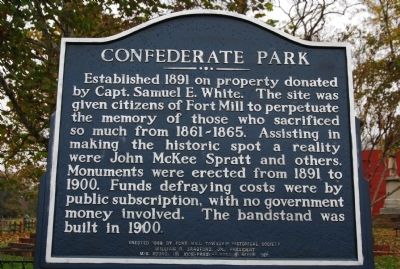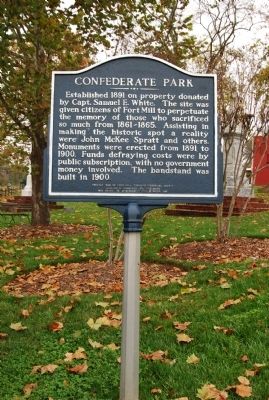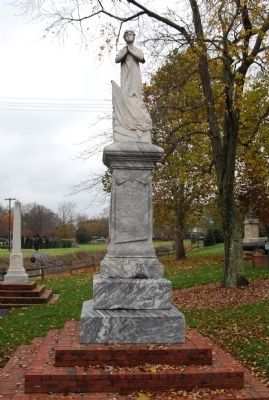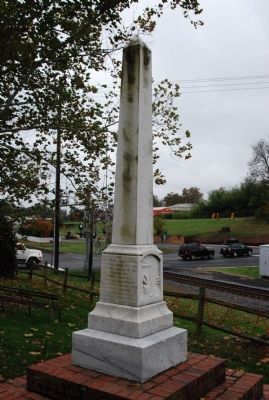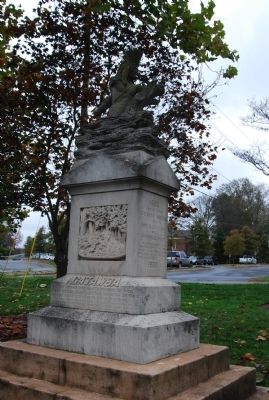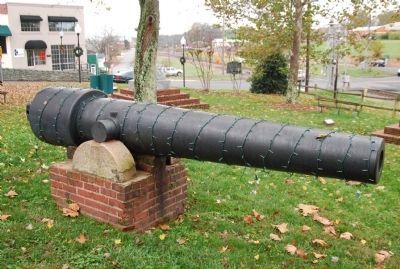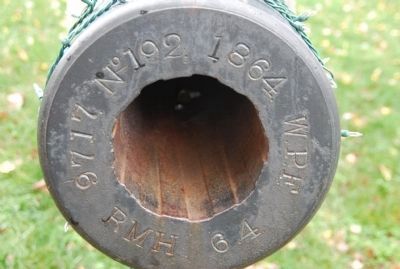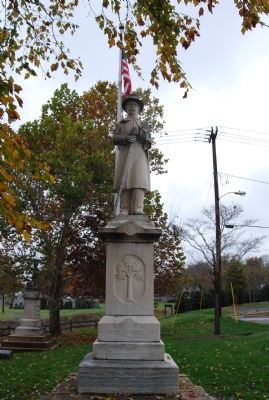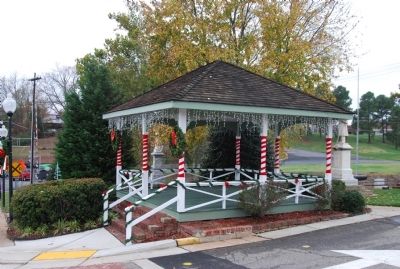Fort Mill in York County, South Carolina — The American South (South Atlantic)
Confederate Park
Established 1891 on property donated by Capt. Samuel E. White. The site was given citizens of Fort Mill to perpetuate the memory of those who sacrificed so much from 1861-1865. Assisting in making the historic spot a reality were John McKee Spratt and others. Monuments were erected from 1891 to 1900. Funds defraying costs were by public subscription, with no government money involved. The bandstand was built in 1900.
Erected 1988 by Fort Mill Township Historical Society.
Topics. This historical marker is listed in these topic lists: Parks & Recreational Areas • War, US Civil. A significant historical year for this entry is 1891.
Location. 35° 0.447′ N, 80° 56.691′ W. Marker is in Fort Mill, South Carolina, in York County. Marker is at the intersection of Main Street and Academy Street, on the left when traveling east on Main Street. Touch for map. Marker is in this post office area: Fort Mill SC 29715, United States of America. Touch for directions.
Other nearby markers. At least 10 other markers are within walking distance of this marker. Women of the Confederacy Memorial (a few steps from this marker); To the Faithful Slaves (within shouting distance of this marker); Fort Mill Confederate Memorial (within shouting distance of this marker); Catawba Indian Memorial (within shouting distance of this marker); 1LT Elliott White Springs (within shouting distance of this marker); Millstone Park (within shouting distance of this marker); Fort Mill (about 300 feet away, measured in a direct line); Catawba Fort (about 500 feet away); Wilson House (about 500 feet away); Unity Presbyterian Church (approx. 0.4 miles away). Touch for a list and map of all markers in Fort Mill.
Additional commentary.
1. Women of the Confederacy Monument
Samuel Elliott White organized the Jefferson Davis Memorial Association in Fort Mill about 1889 and became its first president. Its membership comprised the men and women who had known the hardships of the war. This group subsequently divided into the Ladies' Memorial Association, the Fort Mill Camp of the United Daughters of the Confederacy, the Daughters of the United Confederate Veterans, the Sons of United Confederate Veterans, and Daughters of the American Revolution. This monument was the first erected in the South in memory of the women of the Confederacy, "the finest and best conceived memorial in all our bonnie Southland."
The figure stands on four pedestals of masonry and two steps of marble, a total of seventeen feet in height. It is a highly polished shaft wrought from the finest grained clouded marble. The female figure was carved in Italy of white marble. The woman "has for a moment, while kneeling in supplication for the success of a lost cause, dropped her country's flag around her knees and extended her clasped hands and turned her eyes toward heaven." The citizens of Fort Mill erected the monument in 1895. (Source: A Guide to Confederate Monuments in South Carolina: "Passing the Silent Cup" by Robert S. Seigler (1997), pgs 336-337.)
— Submitted January 6, 2010, by Brian Scott of Anderson, South Carolina.
2. Faithful Slaves Monument
The third monument, also erected in 1895 in Fort Mill's Confederate Park, commemorates the faithful slaves of wartime. The thirteen-foot monument rests on a marble base, which is supported by four steps of masonry. The square shaft is a tapering obelisk of pure white marble. It is a tribute to the "faithfulness of the Southern negro to the women and children of the South during the war...probably the only one of its kind in the South." Samuel Elliott White purchased and unveiled this monument on May 10, 1900. John McKee Spratt, who was preparing to join the Confederacy army at age sixteen when the Confederacy collapsed, helped White with the purchase. Spratt, the great grandson of "Old Kanahwa," had interests in farming, lumber, fertilizer, and the cotton mill in Fort Mill after the war.
The monument commemorates the bravery of the Catawba Indians who served in the Confederate army and lists the names of seventeen of them. Originally, the monument held the statue of a Catawba brave holding a bow and arrow as if stalking game. Over half a century ago, a storm blew down a large oak branch, which served both of the brave's arms and the bow and arrow. The damage was never prepared. (Source: A Guide to Confederate Monuments in South Carolina: "Passing the Silent Cup" by Robert S. Seigler (1997), pgs 338.)
— Submitted January 6, 2010, by Brian Scott of Anderson, South Carolina.
3. Catawba Indian Monument
Samuel Elliott White purchased and unveiled this monument on May 10, 1900. John McKee Spratt, who was preparing to join the Confederacy army at age sixteen when the Confederacy collapsed, helped White with the purchase. Spratt, the great grandson of "Old Kanahwa," had interests in farming, lumber, fertilizer, and the cotton mill in Fort Mill after the war.
The monument commemorates the bravery of the Catawba Indians who served in the Confederate army and lists the names of seventeen of them. Originally, the monument held the statue of a Catawba brave holding a bow and arrow as if stalking game. Over half a century ago, a storm blew down a large oak branch, which served both of the brave's arms and the bow and arrow. The damage was never prepared. (Source: A Guide to Confederate Monuments in South Carolina: "Passing the Silent Cup" by Robert S. Seigler (1997), pgs 340-341.)
— Submitted January 6, 2010, by Brian Scott of Anderson, South Carolina.
4. Fort Mill Confederate Monument
The hamlet of Fort Mill was the site of the organization of one of the first companies raised to defend the South. Captain John M. White commanded this company, known as the Alston Riflemen, and offered its services to South Carolina. Unfortunately, some technicality forced both South Carolina and Alabama to turn down the offer. White later reorganized the company as the York Volunteers, also called the York Guard. It became Company H, 6th S.C.V. Regiment. After the reorganization of the army in 1862, it became Company B, 6th S.C.V. Regiment. White ultimately rose to the rank of lieutenant colonel of the 6th Regiment.
John White's brother, Samuel Elliott White, a former captain of Company B, 7th North Carolina Regiment, organized South Carolina's first branch of the Jefferson Davis Memorial Association in Fort Mill. White conceived the idea of a Confederate park, "a semi-sacred spot" for many Fort Mill citizens.
White, one of the largest property owners in the area, provided the land for the park and led the efforts to erect the four monuments. Although he was financially capable of purchasing them himself, White felt that "if the people of Fort Mill, especially the Confederate veterans, had a part in the purchase of the monuments, it would result in stronger interest and a deeper feeling of pride." On the park's completion, White donated it not to the municipal government but to the people of Fort Mill. The people subscribed to the fund for the monument honoring the Confederate soldiers, the monuments to the women, and the monument to the faithful slaves. White himself purchased the monument to the Catawba Indians.
White and his associates designed the monuments and ordered them cut to exact specifications. The pure marble statue of the Confederate soldier rests on a marble pedestal surmounting a foundation of cour granite elevations, standing sixteen feet. It is obvious that the figure, a Confederate picket standing at challenge, is not the typical design of most other Confederate monuments of the era. In 1891, White unveiled this monument, intending to...honor the Confederate soldiers,
both living and dead, whose names are engraved on the monument. (Source: A Guide to Confederate Monuments in South Carolina: "Passing the Silent Cup" by Robert S. Seigler (1997), pgs 333-334.)
— Submitted January 6, 2010, by Brian Scott of Anderson, South Carolina.
Credits. This page was last revised on September 12, 2022. It was originally submitted on November 25, 2009, by Michael Sean Nix of Spartanburg, South Carolina. This page has been viewed 2,993 times since then and 128 times this year. Photos: 1, 2, 3, 4, 5, 6, 7, 8, 9. submitted on November 25, 2009, by Michael Sean Nix of Spartanburg, South Carolina. • Craig Swain was the editor who published this page.
